Bargain
Travel West guide to unique destinations, sight-seeing, history and
culture, budget travel vacation ideas for the
U.S., Canada and Caribbean.
Travel
Bargain destination in California
CALIFORNIA’S
SCENIC GOLD HISTORIC ROAD
Driving the Forty-Niner Highway State Route 49
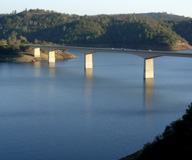 Gold
was discovered in California in 1848 at Sutters Creek near Sacramento and
the “Gold Rush”. Thousands of gold fever would-be miners
left their lives in the east to seek their fortunes in the hills of
California where it was said you could just reach down and pick up
gold in the shallows of the rivers and creeks which coursed through
the foothills of the Sierra Nevada Mountains. The gold seekers soon
discovered the gold was harder and harder to find and the discoveries
of new untapped mining areas spread south along the ridge of mountains.
With the discovery of gold at Woods Creek near Sonora, the Mother Lode
became the place to go, then further south, Mariposa. To supply the
miners, a stage coach road wound its way along through the small camps
and towns, like a string of pearls. By the time the gold was mostly
gone “played out” the stage coach road has become a highway
and one of California’s most familiar scenic drives.
Gold
was discovered in California in 1848 at Sutters Creek near Sacramento and
the “Gold Rush”. Thousands of gold fever would-be miners
left their lives in the east to seek their fortunes in the hills of
California where it was said you could just reach down and pick up
gold in the shallows of the rivers and creeks which coursed through
the foothills of the Sierra Nevada Mountains. The gold seekers soon
discovered the gold was harder and harder to find and the discoveries
of new untapped mining areas spread south along the ridge of mountains.
With the discovery of gold at Woods Creek near Sonora, the Mother Lode
became the place to go, then further south, Mariposa. To supply the
miners, a stage coach road wound its way along through the small camps
and towns, like a string of pearls. By the time the gold was mostly
gone “played out” the stage coach road has become a highway
and one of California’s most familiar scenic drives.
California 49 state highway route, also known as the “Forty-Niner Highway” starts in the south about 40 minutes from Fresno at Oakhurst and ends at Jackson at the north end 15 minutes from Sutters Creek. Many visitors to California think of going to Yosemite National Park and must cross or follow part of the 49er highway to get there, but often don’t consider exploring this great historic road. Along the State 49 Highway can be found some of the best California wine tasting, haunted hotels, steam railroads, gold panning and gold rush history still alive after 140 years, along with , hiking, boating, camping, fishing and skiing in the winter.
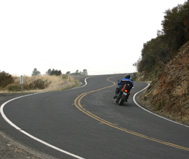 Highway 49 is a modern, well
maintained two-lane road for most of all of its length, but it is not
a fast short cut. There are sectiosn along the present highway where
you can still see the old stage coach route in the twisting around
the deep gullys with aged chunks of early pavement replaced by the
more updtated grading. Yet, parts of the 49 Highway are still quite
curvy, with the section between Mariposa and
Coulterville
especially
twisty with impressive and a bit intimidating steep dropoffs to the river
canyons below. Travel can often be slowed by RVs lumbering around the
corners, with some turnouts and passing areas, but the discoveries along
the way can be well worth the wait.
Highway 49 is a modern, well
maintained two-lane road for most of all of its length, but it is not
a fast short cut. There are sectiosn along the present highway where
you can still see the old stage coach route in the twisting around
the deep gullys with aged chunks of early pavement replaced by the
more updtated grading. Yet, parts of the 49 Highway are still quite
curvy, with the section between Mariposa and
Coulterville
especially
twisty with impressive and a bit intimidating steep dropoffs to the river
canyons below. Travel can often be slowed by RVs lumbering around the
corners, with some turnouts and passing areas, but the discoveries along
the way can be well worth the wait.
Unique Sights and Activities along 49 - South to North
Near Oakhurst you can stay at a California version of a French Chateau, the Chateau Surreau, a member of the Relais & Chateaux group of hotels, or the haunted Sierra Sky Ranch. A few miles up Highway 41 from Oakhurst is the Sugar Pine Steam Railroad just outside the southernmost gate of Yosemite Park at Fish Camp. Traveling up Highway 49 a few miles is the Wasama Indian Round House at Ahwanee, now a small state park preserving the remaining native culture ceremonial round house and ancient village that surrounded it.
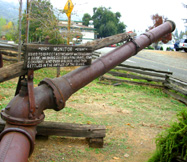 Mariposa claims
a historical connection to the famous bandito of legend Joaquin Murrieta
who it is said had dug a tunnel from this gold mining
town to his hideout in the little town of Hornitos. Like so many legends
about the bandit who supposedly was caught and his head cut off and shown
on tour at local bars in a pickle jar, the tunnel may or may not have
any basis in fact, but is certainly colorful. Just outside Mariposa is
the California
State Mining Museum with magnificent samples of various
stones and minerals connected with the history of gold mining, including
the largest gold nugget ever found in California, locked in a vault with
a glass door. The Mariposa
County Museum has a very interesting recreation of a gold rush era
town inside
the
building
with original
deep mining rig just outside. The fairgrounds holds various event, including
a rodeo and county fairs.
Mariposa claims
a historical connection to the famous bandito of legend Joaquin Murrieta
who it is said had dug a tunnel from this gold mining
town to his hideout in the little town of Hornitos. Like so many legends
about the bandit who supposedly was caught and his head cut off and shown
on tour at local bars in a pickle jar, the tunnel may or may not have
any basis in fact, but is certainly colorful. Just outside Mariposa is
the California
State Mining Museum with magnificent samples of various
stones and minerals connected with the history of gold mining, including
the largest gold nugget ever found in California, locked in a vault with
a glass door. The Mariposa
County Museum has a very interesting recreation of a gold rush era
town inside
the
building
with original
deep mining rig just outside. The fairgrounds holds various event, including
a rodeo and county fairs.
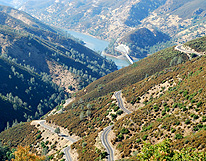 Coulterville was
where the 49 stage route met the original route to Yosemite Valley
used by John
Muir, up Greely Hill. Most distinctive
at Coulterville is the Jeffery
Hotel, which has been hosting guests since 1853, and guesting
ghosts for nearly that long as well. The little museum across the road,
an annex of the Mariposa County Museum is marked by the “Puffy
Billy” steam engine on the corner, looking back on the once vibrant
mining activity which waned and left Coulterville a very quant and sleepy
little corner. The section of US49 between Mariposa and Coulterville,
down to the Merced River and back up is one of the curviest along the
route
with steep embankments, not for the faint of heart.
Coulterville was
where the 49 stage route met the original route to Yosemite Valley
used by John
Muir, up Greely Hill. Most distinctive
at Coulterville is the Jeffery
Hotel, which has been hosting guests since 1853, and guesting
ghosts for nearly that long as well. The little museum across the road,
an annex of the Mariposa County Museum is marked by the “Puffy
Billy” steam engine on the corner, looking back on the once vibrant
mining activity which waned and left Coulterville a very quant and sleepy
little corner. The section of US49 between Mariposa and Coulterville,
down to the Merced River and back up is one of the curviest along the
route
with steep embankments, not for the faint of heart.
At Mocassin, where Highway 49 meets Highway 120, the historic power station standing next to the modern turbines is worth a visit. If you look to the steep hillside above the power turbines you’ll see four massive pipes which carry water from the Hetch-Hetchy Reservoir in the bounds of Yosemite, running all the way underground across the state to supply water to San Francisco. At Mocassin you find a trout fish hatchery and a small little abandoned town built in the 30's to house workers of the Hetch-Hetchy project. Turning up 120 leads to the north gate of Yosemite National Park, and through the town of Groveland with the oldest saloon in California, the “Iron Door” and teepee tents in the summer months.
Crossing the beautiful stunning bridges of the upper end of Don Pedro Reservoir with miles of long fingers of deep blue water against the gold and reds of grass and iron rich soil. Don Pedro Reservoir offers house-boating and bass fishing. Keep an eye out for the Bald Eagles who love this lake and can sometimes be seen soaring or bending tree branches.
Jamestown is just north of the junction of Highway 49 an Highway 108 where they join together for a stretch. The old town of Jamestown has remained much the same since the gold days. There are two original 1850’s era saloon-hotels in “Jimtown”, haunted of course, on the main street and bed and breakfasts. In Jamestown is the famous movie steam train of Rail Town 1897, a State Park offering regular steam train rides and a look into steam rail history.
Just a mile north from Jamestown, look for the stone historic marker for Woods Creek. This is where the second gold discovery in California lead this area to be called the “Mother Load” for its massive amount of gold. Just to the east of the highway you can see the scars of a modern mining operation that returned in the 1990s, now closed and being reclaimed.
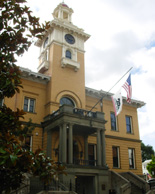 Sonora was
known as the “Queen of the Mother Load”. The
largest city in the mother load Sierra gold region, Sonora has been growing
and sprawling for some years. The central city has passed an ordinance
that new buildings had to look like the historic gold era ones, so the
downtown still retains its historic feeling, but that same feeling doesn’t
hold for the suburban sprawl carrying up Highway 108 toward the Sonora
Pass. It was in Sonora where the infamous “Foreign Miner’s
Tax” meant to chase out Hispanic miners originated. The town gets
its name from Sonora in Mexico where its original “Sonorans” had
come, the first to reach the gold fields. Most Spanish speakers of the
time were refered to as “Sonorans” and ultimately the target
of the influx of white miners from the east and Europe. Notable in Sonora
is the original gold era courthouse which is still in use, the courtroom
nearly unchanged, including its hat racks and boot scrapers. A small
Veterans Museum across the street is also notable. Every spring the Mother
Load Fair is held at the fairgrounds, and the Christmas fair commencing
on Thanksgiving weeked.
Sonora was
known as the “Queen of the Mother Load”. The
largest city in the mother load Sierra gold region, Sonora has been growing
and sprawling for some years. The central city has passed an ordinance
that new buildings had to look like the historic gold era ones, so the
downtown still retains its historic feeling, but that same feeling doesn’t
hold for the suburban sprawl carrying up Highway 108 toward the Sonora
Pass. It was in Sonora where the infamous “Foreign Miner’s
Tax” meant to chase out Hispanic miners originated. The town gets
its name from Sonora in Mexico where its original “Sonorans” had
come, the first to reach the gold fields. Most Spanish speakers of the
time were refered to as “Sonorans” and ultimately the target
of the influx of white miners from the east and Europe. Notable in Sonora
is the original gold era courthouse which is still in use, the courtroom
nearly unchanged, including its hat racks and boot scrapers. A small
Veterans Museum across the street is also notable. Every spring the Mother
Load Fair is held at the fairgrounds, and the Christmas fair commencing
on Thanksgiving weeked.
Columbia State Historic Park is a few short miles from Sonora and completely unique as a surviving gold rush town. Columbia was a mining town that grew to incredible proportions in a few years, then completely died out, though never quite becoming a ghost town. Still a vibrant and living look into gold rush history with lots of activities for kids and historic gold rush era hotels and even a theater where famed actor Edwin Booth (older brother of John Wilkes Booth) and Lily Langtree both performed.
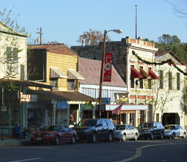 Angles
Camp,
north from Sonora, across the New Melones Reservoir now filling the
Stanislaus River gorge
is
where Mark Twain, then still just
Samuel Clemens first head the story of the Jumping Frog that made his
fame and fortune. Twain had spent a brief cold winter in a cabin on “Jackass
Hill” just outside Angels
Camp. A replica of the cabin is still
in the original spot, look for the signs on the highway between the reservoir
bridge and Angels Camp. Up Highway 4 a few miles from Angels Camp is
Murphys, which has become the center of the Sierra wine
growing region with a Winery
Trail and
historic spots. Murphys has another great historic hotel wher presidents
slept along with bank robbers Murphys
Hotel and
several bed & breakfasts. A few miles farther
up Highway 4 is California Big Trees State Park with its giant Sequoia
Redwood trees. Also nearby is the Moaning
Cavern.
Angles
Camp,
north from Sonora, across the New Melones Reservoir now filling the
Stanislaus River gorge
is
where Mark Twain, then still just
Samuel Clemens first head the story of the Jumping Frog that made his
fame and fortune. Twain had spent a brief cold winter in a cabin on “Jackass
Hill” just outside Angels
Camp. A replica of the cabin is still
in the original spot, look for the signs on the highway between the reservoir
bridge and Angels Camp. Up Highway 4 a few miles from Angels Camp is
Murphys, which has become the center of the Sierra wine
growing region with a Winery
Trail and
historic spots. Murphys has another great historic hotel wher presidents
slept along with bank robbers Murphys
Hotel and
several bed & breakfasts. A few miles farther
up Highway 4 is California Big Trees State Park with its giant Sequoia
Redwood trees. Also nearby is the Moaning
Cavern.
Jackson at the north end of the 49 Highway has a number of antique shops as well as the Amador Country history museum and its colorful historic downtown of restaurants and bars. Two great “tailing wheels” at the Kennedy Mine represent Jackson place as one of the richest of the mines and its Pioneer Cemetery offers a look at the end of the hard mining life. The area from Jackson north is the rich wine region of Amador County. The town of Sutter’s Creek is not where John Marshall discovered the gold nugget in the lumber mill wash, that started the rush, but the town that grew from John Sutter’s efforts to mine it, before he ultimately decided there was more money to be made from supplying miners than from try to dig for gold.
The north end of Highway 49 connects to Highway 50 at Placerville, leading east into Sacramento or west to Lake Tahoe and Reno. North from Placerville you’ll find where the gold rush began at the John Marshall Gold Discovery State Park at Coloma. © Bargain Travel West
Find the best hotel and travel deals in California on TripAdvisor
These articles are copyrighted and the sole property of Bargain Travel West and WLEV, LLC. and may not be copied or reprinted without permission.
See these other travel articles on Bargain Travel West:
A
PASS FOR ALL SEASONS
U.S.
Federal Land and National Park Use Passes
CALIFORNIA
NORTH-SOUTH HIGHWAY ROUTES
Driving to get to the California Scenery
Discover the west with budget travel ideas at Bargain Travel West or visit Bargain Travel Europe for Europe Travel Ideas ©2006-2018 Winged Lion Entertainment Ventures, LLC
